Overview
Selecting the right HVAC brand is crucial for contractors as it significantly impacts service quality, client satisfaction, and long-term business success. The article emphasizes that factors such as reliability, energy efficiency, warranty options, and customer feedback are essential in making informed choices, ultimately leading to fewer breakdowns and enhanced reputation within the industry.
Introduction
In the competitive world of HVAC services, the choice of brand can make or break a contractor’s reputation and success. With an ever-expanding market filled with diverse options, understanding the nuances of brand reliability, energy efficiency, and customer support is essential. Recent trends indicate a significant rise in HVAC repair searches, underscoring the importance of partnering with brands that promise longevity and satisfaction.
As contractors navigate this landscape, they must weigh critical factors such as:
- Warranty coverage
- Compatibility with existing systems
to ensure seamless integration and optimal performance.
This article delves into the intricate decision-making process behind selecting the right HVAC brand, offering insights that empower contractors to enhance their service delivery and foster long-term client relationships.
Understanding the Importance of Choosing the Right HVAC Brand
Choosing the suitable HVAC brands for heating and cooling systems is essential for contractors dedicated to providing excellent services and attaining high client satisfaction. The market for heating and cooling features a variety of HVAC brands, each offering differing levels of reliability, efficiency, and client support. According to recent trends, searches for HVAC repair have surged by 20% year-over-year, highlighting the critical nature of selection.
Contractors who collaborate with HVAC brands recognized for their anticipated reliability and client satisfaction often enjoy considerable advantages, including:
- Fewer breakdowns
- Reduced service calls
These advantages ultimately improve their reputation. Mary H.J. Farrell, a senior editor at Consumer Reports, emphasizes that the appropriate choice can make a substantial difference in performance and customer loyalty.
Moreover, the implications of product selection from HVAC brands extend beyond immediate service outcomes; they influence warranty claims and long-term client relationships. As the heating and cooling sector progresses, especially with retrofitted structures making up 67% of the market, understanding the subtleties of HVAC brands’ reliability becomes crucial for knowledgeable decision-making that benefits both builders and their clients. Additionally, taking into account the financial factors, the average salary of heating, ventilation, and air conditioning technicians is about $57,040, with variations depending on the companies they collaborate with.
This financial insight emphasizes the significance of selecting a dependable heating and cooling company that not only aids contractor success but also enhances the overall sustainability of the industry.
Key Factors to Consider When Evaluating HVAC Brands
In the competitive landscape of HVAC brands, evaluating options requires a focused approach on several pivotal factors:
- Reliability
- Energy efficiency
- Warranty coverage
- Customer support
Reliability serves as a cornerstone, often assessed through industry reviews and product testing outcomes, which provide a clear picture of a company’s performance over time. Energy efficiency is equally crucial, as it not only influences operating costs but also aligns with local regulations aimed at reducing environmental impact.
According to recent studies, brands that incorporate energy-efficient technologies, such as geothermal heat pumps, can reduce energy consumption by up to 44% compared to traditional systems. This significant reduction highlights the necessity of considering energy efficiency ratings when choosing heating and cooling systems. Moreover, inquiries for HVAC repair have risen 20% annually, highlighting the growing significance of reliability and support in the industry.
Warranty coverage is another essential aspect; HVAC brands that offer comprehensive warranties demonstrate confidence in their products, which reassures builders about long-term reliability. Lastly, customer support is a vital element that cannot be overlooked. HVAC brands with responsive and knowledgeable support teams can expedite service and minimize downtime, ultimately enhancing worker satisfaction and client trust.
For instance, a recent case study by Williams Comfort Air discusses the top HVAC brands for air conditioning manufacturers suitable for homes in Indianapolis, providing guidance for homeowners and illustrating how these evaluation factors apply in real-world scenarios. Grasping these elements will enable builders to make knowledgeable decisions that not only satisfy client demands but also place them advantageously in the changing heating and cooling industry.
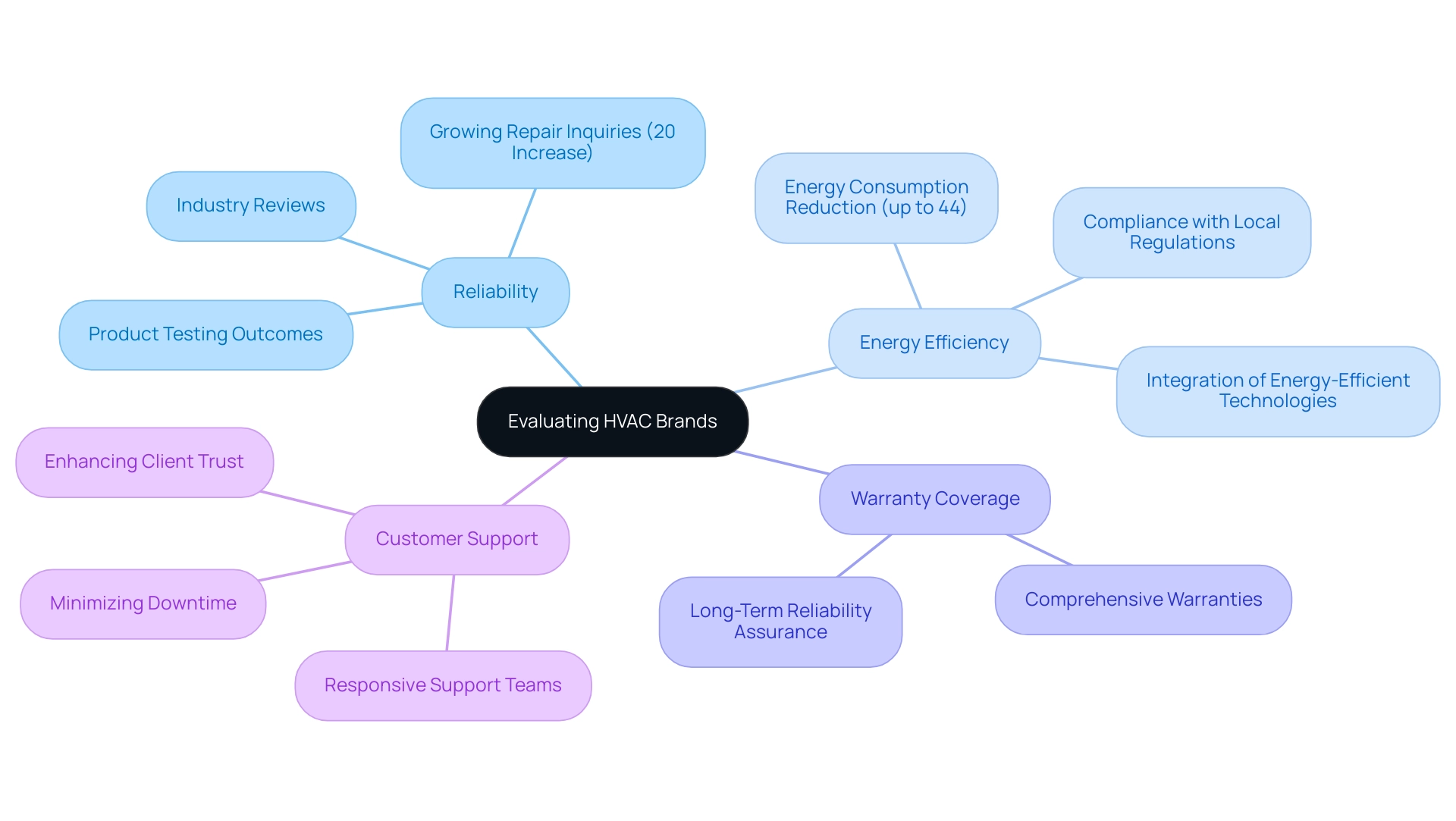
Leveraging Brand Reputation and Customer Feedback
For heating and cooling specialists, actively seeking client opinions and evaluating company reputation is essential when choosing products. Matthew Miller, CEO of Onsite Mastery, exemplifies this approach, sharing how Field Complete’s customer success services transformed their field operations. He noted that while implementation required more than just purchasing the software, the comprehensive training and data-driven insights provided made all the difference in achieving improved performance and growth.
Notably, having a dedicated support manager facilitated this process, ensuring that their team received tailored assistance throughout the implementation phase. With the increasing impact of online evaluations, testimonials, and case studies, builders can acquire invaluable insights into the trustworthiness and efficiency of various HVAC brands. Recent statistics show that 80% of consumers depend on online reviews to guide their purchasing choices, highlighting the necessity for service providers to emphasize companies with strong reputations.
Interacting with other professionals through forums and industry associations can provide firsthand experiences that uncover both strengths and weaknesses of particular companies. For example, while some HVAC brands may be praised for their high efficiency, they might also encounter criticisms concerning service quality. Balancing these positive aspects with potential drawbacks enables professionals to make informed choices that not only align with their business values but also fulfill client expectations.
Additionally, the heat exchanger market is growing at a rate of 11.1% per year, reflecting an increasing demand for efficient systems that contractors should consider. As the heating and cooling market develops, particularly with forthcoming alterations such as the phase-out of refrigerant R410-A, which is anticipated to raise system costs by 10-15%, remaining attentive to client feedback will be essential in managing product choice and preserving a competitive advantage. Miller’s experience reinforces the importance of leveraging customer success services for operational excellence, ultimately leading to measurable improvements in performance and growth.
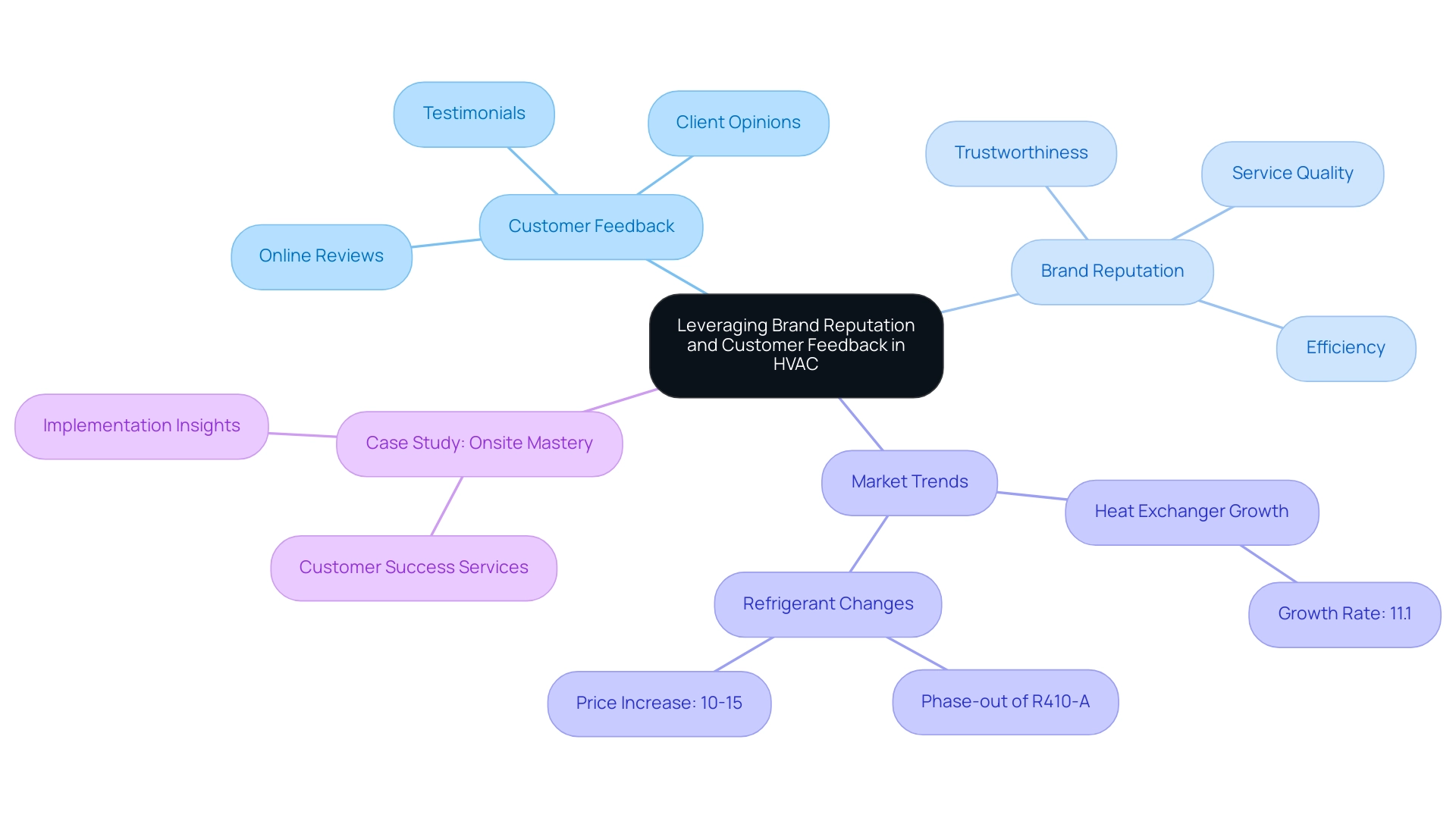
The Role of Energy Efficiency and Sustainability in Brand Selection
When selecting HVAC brands, energy efficiency and sustainability are crucial factors to consider. With approximately 3 million HVAC units replaced annually in the U.S., contractors must recognize that as regulations tighten, consumers are increasingly attracted to companies that emphasize energy-efficient technologies. Products boasting high SEER (Seasonal Energy Efficiency Ratio) ratings not only contribute to significant reductions in energy consumption but also resonate with eco-conscious customers.
As a Senior Manager at Advanced Technology Corporation stated, ‘I have reviewed the report and find it very useful and comprehensive,’ underscoring the importance of energy efficiency in brand selection. HVAC brands that are dedicated to sustainable practices frequently experience an enhancement in their reputation, rendering them more attractive to professionals seeking to offer environmentally friendly solutions. For example, case studies show that companies adopting energy-efficient systems can produce significant long-term savings, benefiting both builders and their clients.
As we transition into 2024, the landscape of energy-efficient heating and cooling technologies continues to evolve, presenting a range of options that align with the growing demand for sustainability in the industry.
Ensuring Compatibility with Existing Systems and Technologies
When choosing a heating and cooling system, it is crucial for contractors to assess how effectively new systems will work with current technologies. This assessment includes checking compatibility with current ductwork, thermostats, and other heating and cooling components. Modular systems have emerged as a pivotal trend in the industry, offering enhanced installation flexibility that can accommodate various client needs.
For instance, many HVAC brands provide units designed for easy integration, which can prevent the complications associated with unique specifications requiring additional modifications. Failure to ensure compatibility can lead to significant issues, such as improper sizing and inadequate duct sealing, which often result in frequent equipment cycling, increased energy consumption, and higher repair costs. Alarmingly, a significant percentage of heating, ventilation, and air conditioning systems in American homes are installed incorrectly, leading to these issues; as highlighted in the case study ‘What Percentage of Heating, Ventilation, and Air Conditioning Systems Are Installed Incorrectly?’
Improper installation can cause substantial efficiency losses. Dr. John Gorrie emphasized the importance of maintaining comfort and reducing health risks, stating, “He wanted to keep southern hospitals more comfortable as well as lessen the incidence of heat-born diseases like malaria.” By prioritizing compatibility with HVAC brands, builders not only enhance operational efficiency but also significantly improve client satisfaction, making informed decisions on system selection more critical than ever.
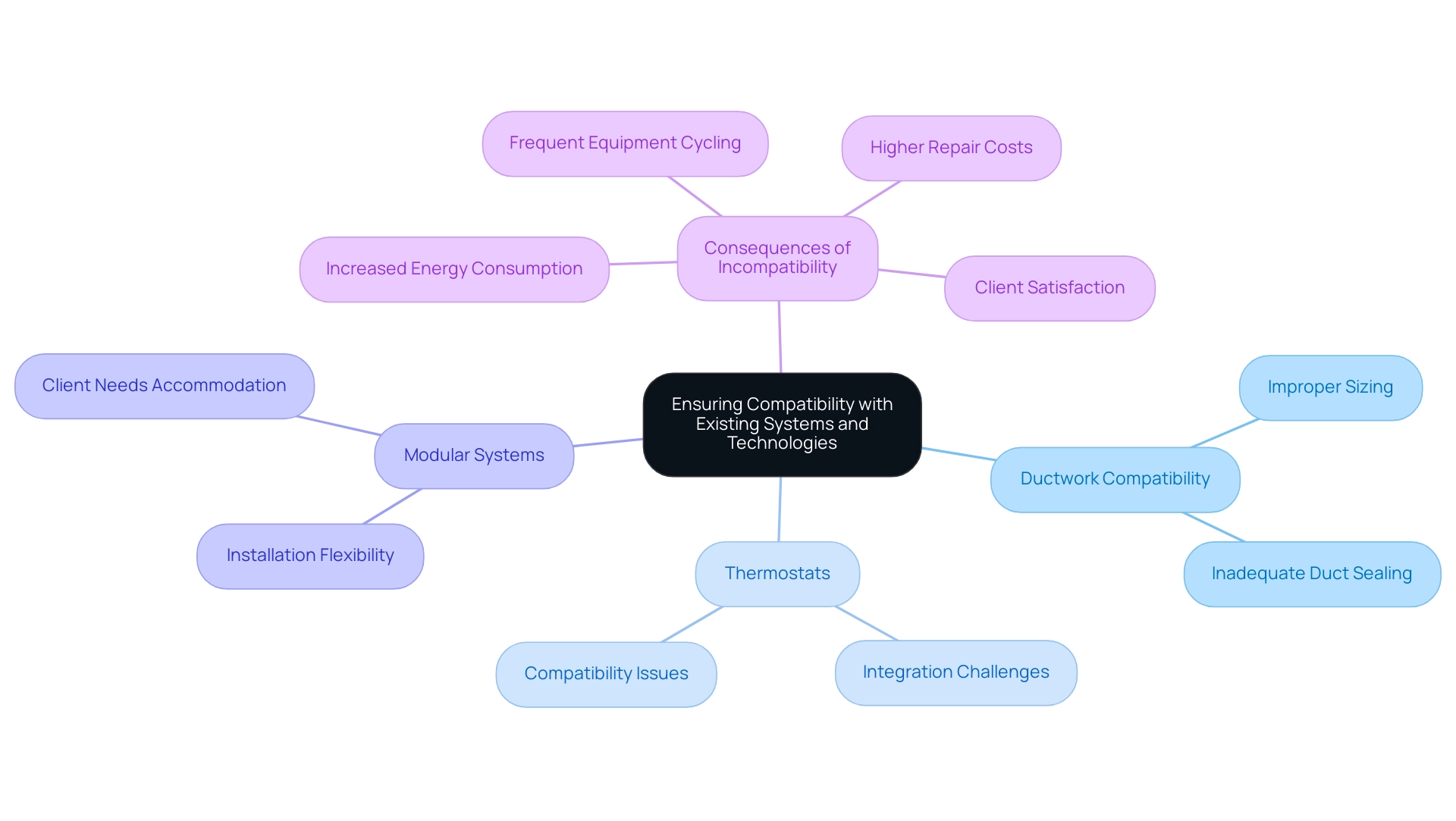
Evaluating Long-Term Support and Service Options from Brands
Professionals must thoroughly evaluate the long-term support and service options that each HVAC brand offers when choosing HVAC brands. This critical evaluation includes not only the warranty terms but also the availability of replacement parts and the responsiveness of service teams. HVAC brands that offer comprehensive training programs and strong technical support can greatly enhance a service provider’s capability to assist their clients effectively.
Terence Chan from Impetus Plumbing and Heating emphasizes this point, stating,
My advice is to lean into learning a new skill, do the hard work that’s required, and in the end, you become a master at the craft.
A company that invests in continuous training guarantees that workers remain informed about the latest technologies and installation methods, which ultimately results in enhanced service delivery and greater client loyalty. Furthermore, as the heating and cooling sector evolves, trends in company support and service options for 2024 highlight the growing demand for extensive warranty coverage, which, if registered within 60 days of installation, can extend for up to 10 years.
This proactive strategy for warranty management not only builds consumer trust but also reduces potential expenses related to repairs; in 2025, these costs are estimated to range from $85 to $170 for maintenance throughout the U.S. Furthermore, the increasing popularity of ductless heating and cooling systems, recognized for their efficiency and simplicity of installation, further highlights the necessity for professionals to be knowledgeable about the products they select. Lastly, the case study titled ‘Importance of Proper Installation and Maintenance’ emphasizes that correct installation by licensed professionals is crucial for warranty validity, and annual maintenance is often required to keep warranties active and ensure system efficiency.
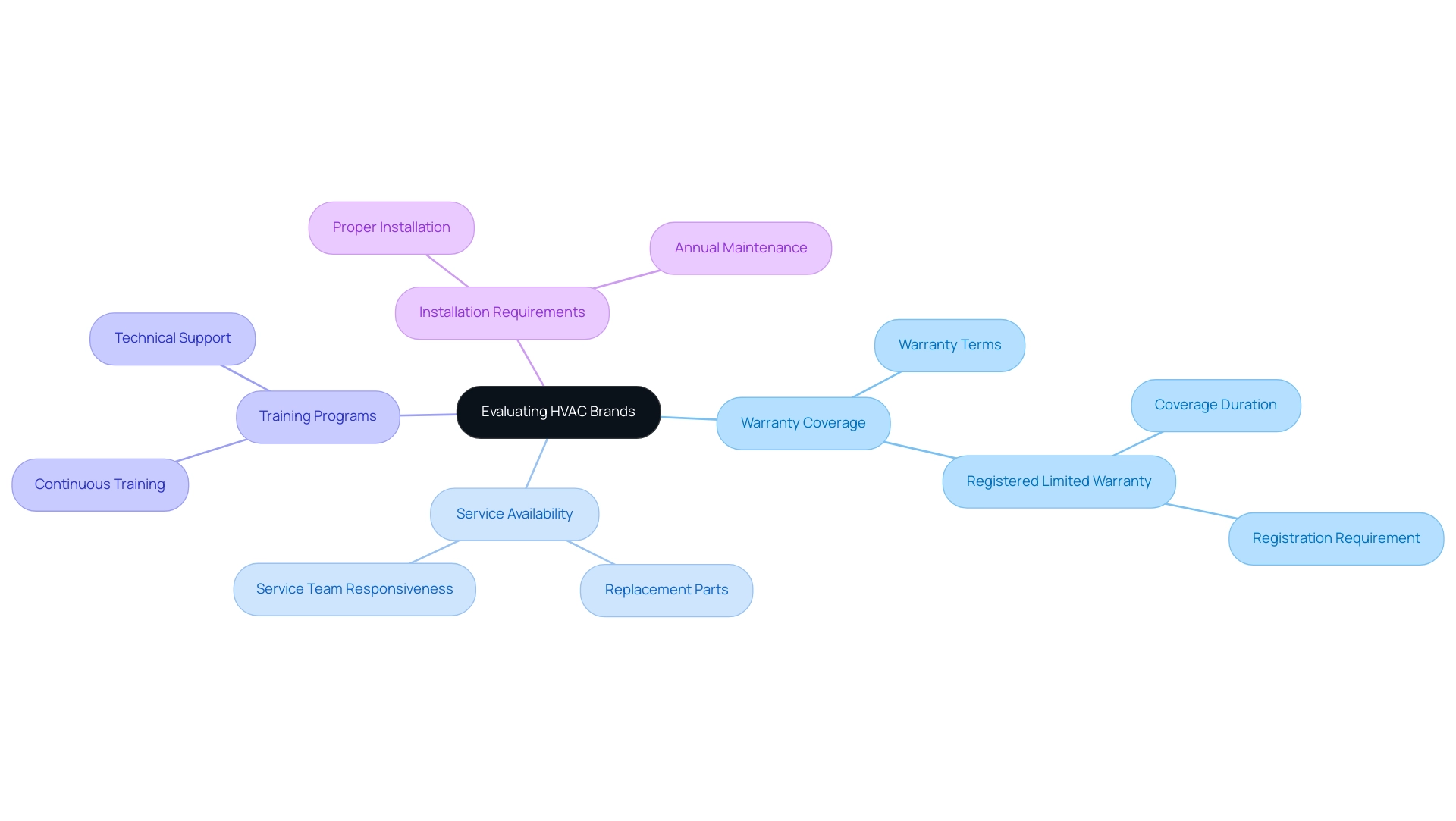
Best Practices for Selecting HVAC Brands: A Summary
Choosing the appropriate HVAC brands is crucial for builders, as it directly affects business performance and client satisfaction. Key factors to consider include:
- Reliability
- Energy efficiency
- Warranty options
Significantly, retrofit buildings represent 67% of the heating and cooling services market, emphasizing the importance of this segment in the decision-making process for contractors.
The growing trend of ductless HVAC systems underscores the industry’s shift toward more efficient and easily installed solutions, making them an appealing choice for retrofit projects. Furthermore, customer feedback plays a vital role in product selection. Engaging with clients about their experiences can provide invaluable insights into product performance and support.
As Terence Chan, Owner of Impetus Plumbing and Heating, states, “I was 20 when I became a plumber and started Impetus Plumbing & Heating at 23. Today we employ six people and generate more than $1 million in revenue annually.” This highlights the significance of choosing a label in attaining business success.
To further improve operational efficiency and company visibility, heating and cooling professionals should consider utilizing Field Complete’s comprehensive service management solutions. These tools streamline operations through features such as:
- Real-time scheduling
- Customer management
- Performance analytics
This enhances customer engagement and ultimately strengthens the entity’s online presence. Furthermore, as the market develops, especially with expected price hikes resulting from new regulations like the AIM Act and the elimination of refrigerant R410-A—which is projected to cause a 10-15% rise in HVAC system costs—it is essential for professionals to prioritize HVAC brands that demonstrate a commitment to sustainability objectives and long-term support.
By systematically evaluating these factors and integrating effective software solutions, contractors can make informed choices that not only enhance operational efficiency but also foster loyalty among their clientele. Elevate your home repair brand online today by exploring how Field Complete’s solutions can transform your business operations.
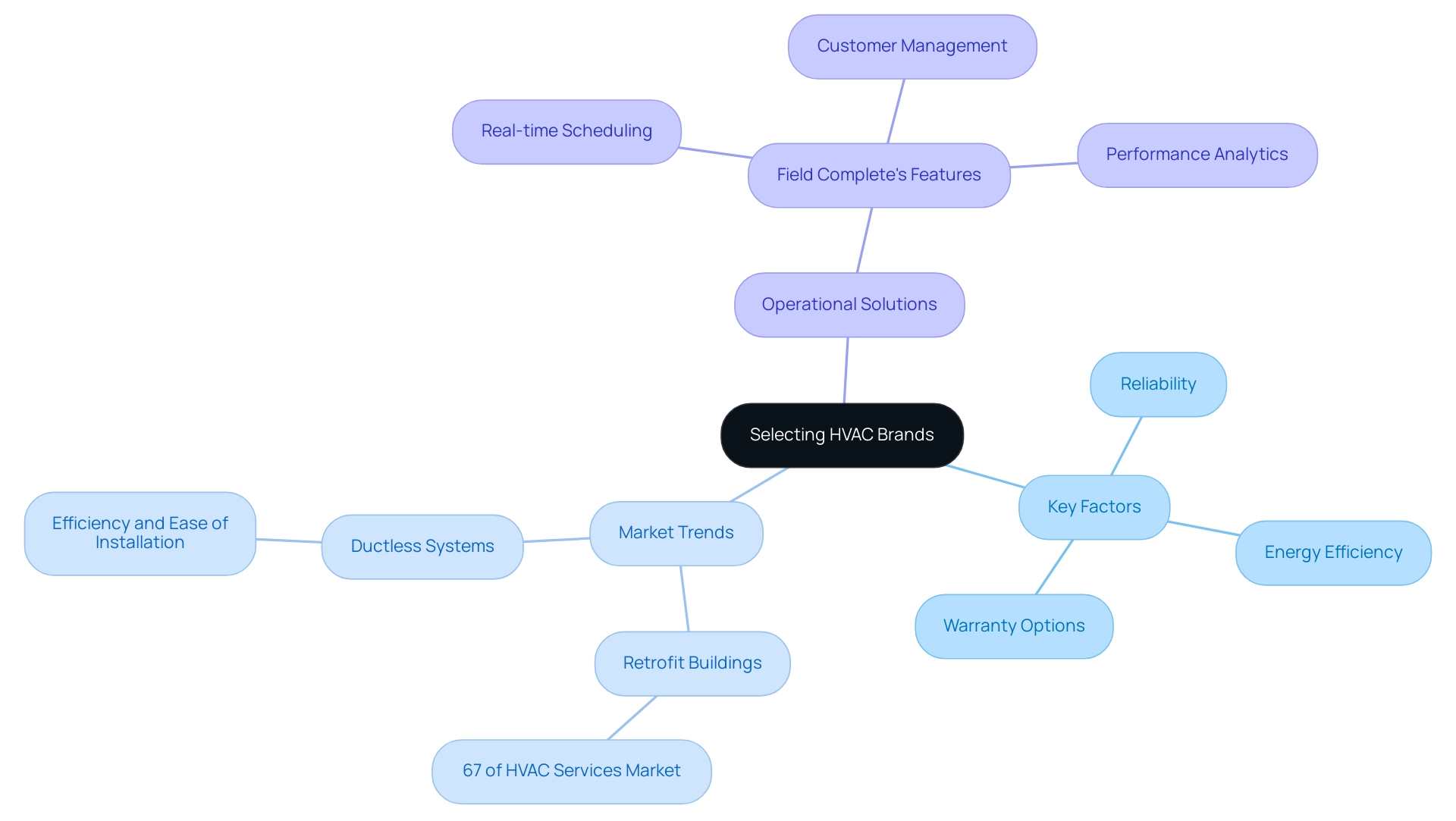
Conclusion
Selecting the right HVAC brand is paramount for contractors aiming to deliver exceptional service and build lasting client relationships. The article highlights several critical factors that influence brand choice, including:
- Reliability
- Energy efficiency
- Warranty coverage
- Customer support
With the HVAC market witnessing a surge in repair searches, the significance of these elements becomes increasingly clear. Contractors who prioritize brands known for their reliability and customer satisfaction can expect not only improved service outcomes but also a bolstered reputation in a competitive landscape.
In addition, the importance of energy efficiency and sustainability is emphasized as contractors navigate evolving regulations and consumer preferences. Brands that offer energy-efficient technologies not only meet regulatory demands but also attract eco-conscious customers, driving long-term loyalty. Compatibility with existing systems and the provision of robust long-term support options further enhance the decision-making process, ensuring that contractors can deliver seamless service while minimizing operational disruptions.
Ultimately, the insights presented underscore that informed brand selection is more than just a business decision; it is a strategic move that impacts operational efficiency and client satisfaction. By leveraging customer feedback, staying attuned to market trends, and utilizing effective service management solutions, HVAC contractors can position themselves for success in an ever-evolving industry. Embracing these best practices will not only enhance service delivery but also foster a sustainable and prosperous future for HVAC businesses.
Frequently Asked Questions
Why is choosing the right HVAC brand important for contractors?
Choosing the right HVAC brand is essential for contractors as it affects service quality, client satisfaction, and reputation. Brands known for reliability and client support lead to fewer breakdowns and reduced service calls.
What are the advantages of collaborating with reliable HVAC brands?
Collaborating with reliable HVAC brands leads to fewer breakdowns and service calls, which ultimately enhances the contractor’s reputation and fosters customer loyalty.
How does HVAC brand selection impact warranty claims and client relationships?
The selection of HVAC brands influences warranty claims and long-term client relationships, as reliable brands tend to have fewer issues, which can lead to smoother claims processes and stronger client trust.
What factors should contractors evaluate when choosing HVAC brands?
Contractors should focus on several pivotal factors when evaluating HVAC brands, including reliability, energy efficiency, warranty coverage, and customer support.
How does energy efficiency influence HVAC brand selection?
Energy efficiency is crucial as it affects operating costs and compliance with local regulations aimed at reducing environmental impact. Brands that use energy-efficient technologies can significantly lower energy consumption.
What role does warranty coverage play in HVAC brand selection?
Warranty coverage is vital as it reflects a brand’s confidence in its products. Comprehensive warranties reassure builders about the long-term reliability of the HVAC systems.
Why is customer support important when selecting HVAC brands?
Responsive and knowledgeable customer support is important as it can expedite service and minimize downtime, enhancing both worker satisfaction and client trust.
What recent trends highlight the importance of HVAC brand reliability?
There has been a 20% annual increase in inquiries for HVAC repair, underscoring the growing significance of reliability and support in the HVAC industry.
What financial factors should contractors consider when selecting HVAC brands?
Contractors should consider the average salary of HVAC technicians, which is about $57,040, and how the choice of HVAC brand can influence contractor success and industry sustainability.
List of Sources
- Understanding the Importance of Choosing the Right HVAC Brand
- HVAC Industry Statistics (https://webfx.com/industries/home-repair/hvac/marketing-statistics)
- bookcleango.com (https://bookcleango.com/blog/hvac-statistics)
- Most Reliable Central Air Conditioning Systems – Consumer Reports (https://consumerreports.org/appliances/central-air-conditioning/most-reliable-central-air-conditioning-systems-a5246005663)
- Key Factors to Consider When Evaluating HVAC Brands
- HVAC Industry Trends You Need To Know in 2024 | SBE (https://sbeodyssey.com/blog/hvac-industry)
- 50 HVAC Industry and Marketing Statistics (Verified) (https://seoexpertscompanyindia.com/hvac-industry-and-marketing-statistics)
- Best HVAC System Brands Ranked in America’s Most Trusted Study — Lifestory Research (https://lifestoryresearch.com/2024-best-hvac-ranking-review)
- HVAC Industry Statistics (https://webfx.com/industries/home-repair/hvac/marketing-statistics)
- What Is the Most Reliable AC Brand for 2024? (https://williamscomfortair.com/knowledge-center/reliable-indianapolis-air-conditioner-brands)
- Leveraging Brand Reputation and Customer Feedback
- 50 HVAC Industry and Marketing Statistics (Verified) (https://seoexpertscompanyindia.com/hvac-industry-and-marketing-statistics)
- 2025 HVAC Industry Trends and Statistics to Know for Success (https://getjobber.com/academy/hvac/hvac-industry-trends)
- HVAC Industry Statistics (https://webfx.com/industries/home-repair/hvac/marketing-statistics)
- The Role of Energy Efficiency and Sustainability in Brand Selection
- Real world heating data for 2024 in the cold (https://f150lightningforum.com/forum/threads/real-world-heating-data-for-2024-in-the-cold.23071/page-3)
- HVAC Industry Statistics (https://webfx.com/industries/home-repair/hvac/marketing-statistics)
- HVAC Systems Market Size & Industry Growth 2030 (https://futuredatastats.com/hvac-systems-market?srsltid=AfmBOooCZDaWOxdNMSSKxZ0BGY0hVm_jKzGjHREGHAtzhSJPGZWRok-o)
- Ensuring Compatibility with Existing Systems and Technologies
- paylesspower.com (https://paylesspower.com/blog/air-conditioning-statistics)
- Common Mistakes: What Percentage of HVAC Systems Are Installed Incorrectly (https://dowdheatandair.com/blog/common-mistakes-what-percentage-of-hvac-systems-are-installed-incorrectly)
- 2025 HVAC Industry Trends and Statistics to Know for Success (https://getjobber.com/academy/hvac/hvac-industry-trends)
- Evaluating Long-Term Support and Service Options from Brands
- 2025 HVAC Industry Trends and Statistics to Know for Success (https://getjobber.com/academy/hvac/hvac-industry-trends)
- How Do I Find Out if My HVAC Unit is Under Warranty? (https://ecicomfort.com/blog/how-to-find-hvac-warranty)
- Best Practices for Selecting HVAC Brands: A Summary
- HVAC Industry Statistics (https://webfx.com/industries/home-repair/hvac/marketing-statistics)
- 2025 HVAC Industry Trends and Statistics to Know for Success (https://getjobber.com/academy/hvac/hvac-industry-trends)





